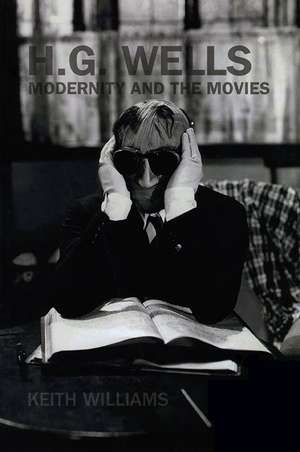H.G. Wells, Modernity and the Movies
Autor Keith Williamsen Limba Engleză Paperback – 14 mar 2008
Everyone is familiar with H.G. Wells’s pioneering works of science fiction, The War of the Worlds, The Time Machine, and The Invisible Man—but fewer realize how these works helped to technically develop the cinematic narrative. An appealing and accessible study aimed at the student of modernism and early cinema, H.G. Wells, Modernity, and the Movies reconsiders Well’s advancement of the cinematic narrative alongside the social and political impact of early media. Including rare illustrations from the original magazines which published Wells’s early work, this groundbreaking study will be of interest to anyone concerned with Wells, his work, and the technological parameters of modern culture.
Preț: 254.27 lei
Nou
Puncte Express: 381
Preț estimativ în valută:
48.65€ • 50.80$ • 40.27£
48.65€ • 50.80$ • 40.27£
Carte tipărită la comandă
Livrare economică 05-19 aprilie
Preluare comenzi: 021 569.72.76
Specificații
ISBN-13: 9781846310607
ISBN-10: 1846310601
Pagini: 256
Ilustrații: 8 halftones
Dimensiuni: 152 x 229 x 18 mm
Greutate: 0.45 kg
Editura: Liverpool University Press
Colecția Liverpool University Press
Locul publicării:United Kingdom
ISBN-10: 1846310601
Pagini: 256
Ilustrații: 8 halftones
Dimensiuni: 152 x 229 x 18 mm
Greutate: 0.45 kg
Editura: Liverpool University Press
Colecția Liverpool University Press
Locul publicării:United Kingdom
Notă biografică
Keith Williams is senior lecturer in English literature at Dundee University and a recent consultant to BBC 4’s trilogy of programs on the history of British science fiction, The Martians and Us.
Cuprins
Introduction
Chapter 1
Optical Speculations in the Early Writings: The Time Machine and the Short Stories
Chapter 2
The Dis/Appearance of the Subject: Wells, Whale and The Invisible Man
Chapter 3
‘Seeing the Future’: Visual Technology and Urban Dystopia in When the Sleeper Wakes and Fritz Lang’s Metropolis
Chapter 4
The ‘Broadbrow’ and the Big Screen: Wells’s Film Writing
Things to Come and The Man Who Could Work Miracles
Chapter 5
Afterimages: Adaptations and Influences
Chapter 1
Optical Speculations in the Early Writings: The Time Machine and the Short Stories
Chapter 2
The Dis/Appearance of the Subject: Wells, Whale and The Invisible Man
Chapter 3
‘Seeing the Future’: Visual Technology and Urban Dystopia in When the Sleeper Wakes and Fritz Lang’s Metropolis
Chapter 4
The ‘Broadbrow’ and the Big Screen: Wells’s Film Writing
Things to Come and The Man Who Could Work Miracles
Chapter 5
Afterimages: Adaptations and Influences
Conclusion
